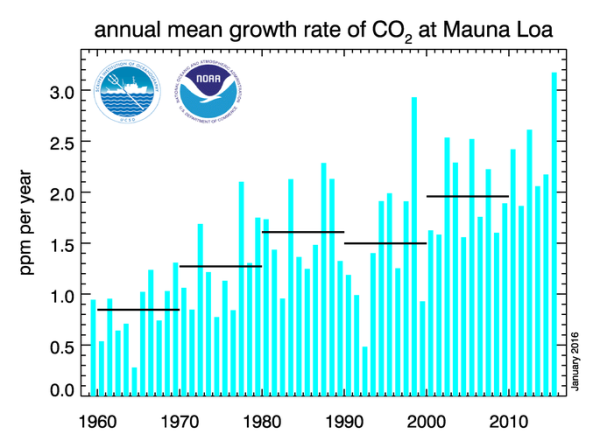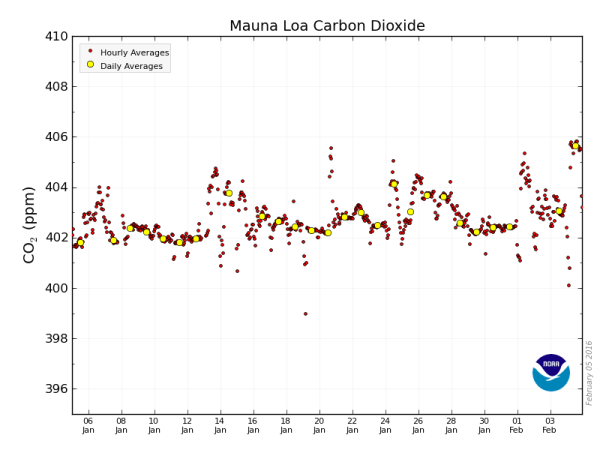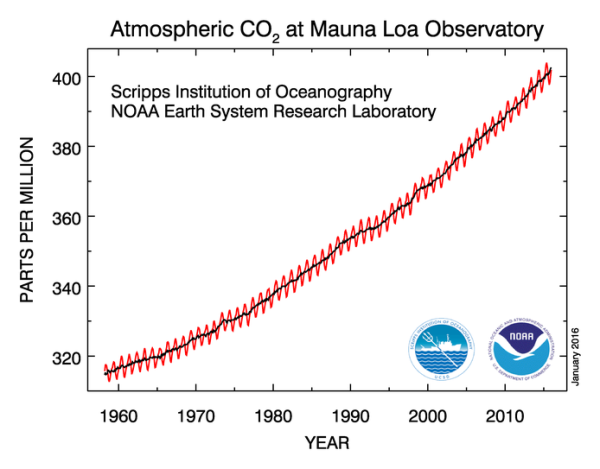Atmospheric CO2 Rocketed to 405.6 ppm Yesterday — A Level not Seen in 15 Million Years
5
February, 2016
As
CO2 levels hit a new record global high of 405.66 ppm yesterday, I
couldn’t help but think that HG Wells could not have imagined a
more perilous mechanism for exploring the world’s past.
For
when it comes to testing the range of new climate extremes, the
present mass burning of fossil fuels is like stepping into a dark
time machine. As all that carbon hits the airs and waters, the
climate dial spins backward through hundreds of thousands and
millions of years. Speeding us on toward the hothouse extinction eras
of Earth’s deep history. Now, not only is it driving us on through
extreme weather and temperature events not seen in 100, 1,000, 5,000
or even 10,000 years, it is also propelling us toward climate states
that haven’t occurred on Earth for ages and ages.
*****
Ever
since 1990, the world has experienced atmospheric CO2 levels in a
range that hasn’t been seen since the Pliocene geological epoch. A
period of time 2.6 – 5.3 million years ago hosting
carbon dioxide levels ranging from 350 to 405 parts per million and
global average temperatures that were 2-3 degrees Celsius hotter than
1880s levels. Overall,
global sea levels towered about 80 feet higher than those humankind
has grown accustomed to.
(Never
has the Earth seen a CO2 build-up so rapid as the one produced by the
human fossil fuel energy era. Rates of CO2 increase just keep ramping
higher ever as the world’s climate sinks appear to be filling up.
In this context, 2015 saw the swiftest pace of CO2 rise yet. Warming
ocean surface waters can’t absorb as much CO2 as cooler oceans. And
a record hot ocean during 2015 contributed to this extreme
atmospheric CO2 accumulation. For the whole of the past year, CO2
built up in the atmosphere at a rate of 3.2 parts per million per
annum. That’s well above the already raging pace of 2 parts per
million average annual accumulation during the decade of the 2000s.
Image source: NOAA
ESRL.)
If
global atmospheric CO2 levels had stabilized in this range, it’s
likely that we would have eventually seen climates, temperatures, and
sea levels that became more and more like those experienced 2-5
million years ago. A process that would have likely taken centuries
to reach a final, far warmer climate state. One in which little to no
ice remained upon Greenland or West Antarctica, and one hosting a
substantial retreat of coastlines.
From
1990 through 2015, that was our climate context. The new world that
was steadily settling into place. One that would eventually assert
itself unless atmospheric CO2 levels were somehow drawn down to below
350 parts per million. It was kind of a big deal. Unfortunately, few
experts really talked about it.
Exiting
the Pliocene
But
starting in 2015 and continuing on into 2016 the fossil fuel burning
time machine again cranked us back toward hotter, more dangerous
times. For during the past two years we began to exceed the maximum
CO2 threshold of the Pliocene and
we started to enter CO2 ranges that were more typical to those of the
Middle Miocene climate epoch of 15 to 17 million years ago.
(Rocketing
on past the Pliocene. On February 4 of 2016, a record daily
atmospheric CO2 level of 405.66 was recorded at the Mauna Loa
Observatory. The Earth hasn’t experienced CO2 levels this high in
15-17 million years. Image source: NOAA
ESRL.)
By
late April of 2015, as CO2 approached its typical May high point,
daily readings had hit a range of 404.9 parts per million —
propelling us toward the outside boundary of the Pliocene climate
context. For a brief period of 9 months, CO2 retreated back from the
Pliocene boundary as spring and summer-time plants in the Northern
Hemisphere respired. However, average atmospheric CO2 levels were
still ramping higher as a rampant burning of fossil fuels around the
world continued. By
yesterday, February 4, 2016, daily CO2 levels at the Mauna Loa
Observatory had rocketed to 405.66 parts per million.
A level well outside the upper range for the Pliocene climate epoch.
One more typical for periods seen during the Miocene of 15-17 million
years ago.
Entering
the Middle Miocene
Unfortunately,
this daily Februay peak at 405.66 parts per million is not the end to
the current year’s ramp up. Typical atmospheric peaks occur during
May. And this year, we are likely to see atmospheric levels hit near
407 parts per million in the weekly and monthly averages over the
next few months. Such a range thrusts us solidly out of the Pliocene
climate context and well into that of the Miocene.
Though
the Middle Miocene was not a hothouse extinction climate, it was one
much more foreign to humankind. Back then, only the great apes
existed. Our most ancient ancestor, Australopithecus, was still at
least 9 million years in the future. It’s fair to say that no human
being, or even our closer offshoot relatives, have ever breathed air
with the composition that is now entering our lungs. Never lived
under the oppressive and intensifying dome of such a great global
atmospheric heat forcing.
(We
said farewell to the Holocene climate context when CO2 levels rose
above 280 parts per million back during the 19th Century. By around
1990, we had begun to enter the Pliocene context, a period occurring
2-5 million years ago. As of 2015, we had begun to exit the Pliocene
climate context and enter the Middle Miocene. If current rates of
fossil fuel burning or business as usual rates of fossil fuel
build-up continue, we will be entering the Ogliocene climate context
in about 25 to 50 years. Image source: NOAA
ESRL.)
We
are now entering a period in which atmospheres are more similar to
those seen during the Middle
Miocene Climate Optimum —
the last time CO2 measures exceeded a threshold of roughly 405 parts
per million (see here and here).
The
Middle Miocene Climate Optimum of
15-17 million years ago was a radically different world. It
hosted an atmosphere in which carbon dioxide levels varied wildly
from 300 parts per million to 500 parts per million. Temperatures
were between 3 to 5 degrees Celsius hotter than the 19th Century. And
sea levels were about 120 to 190 feet higher.
During this period, the world was still cooling down from the heat of
the Paleocene and Eocene epochs. Carbon was being sequestered. And it
was the first time the world broke significantly below a 500
part per million CO2 plateau that had been established during the
Oligocene 24 to 33 million years ago.
If
CO2 levels remain in this range, these are the temperatures, sea
levels, and climate conditions we will transition to and ultimately
experience. But time, and fossil fuel burning, is not on our side.
For under business as usual fossil fuel burning rates of increase, we
could hit the Oligocene threshold within as little as 25-30 years.
And even if the current rate of increase were maintained, the
Oligocene boundary sits about 5 decades away.
Links:
NOAA
ESRL (Please
support public, non-special interest based, science like the
fantastic and essential work produced by the experts at NOAA.)
Hat
tip to Kevin Jones






No comments:
Post a Comment
Note: only a member of this blog may post a comment.